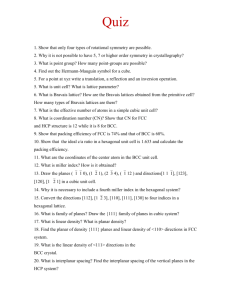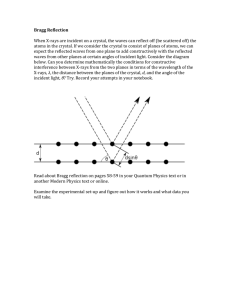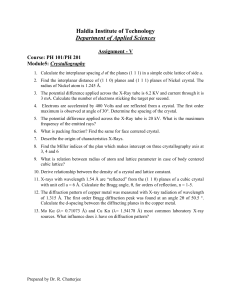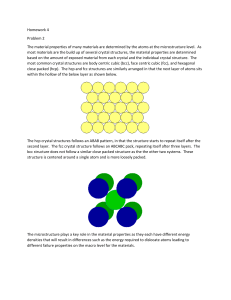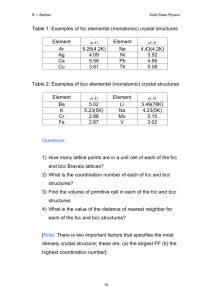Crystal Structure Basics: Lattices, Symmetry, and Miller Indices
advertisement
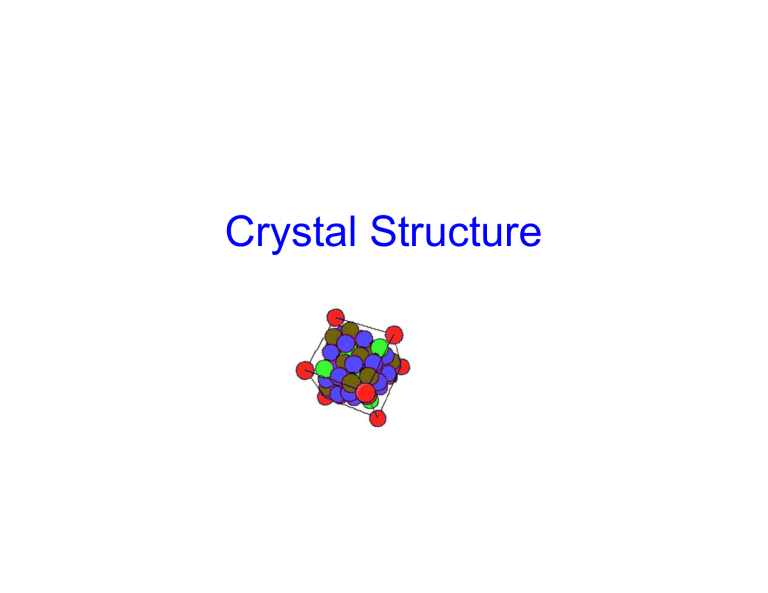
Crystal Structure
Preface
Crystal structure is one of the most important aspects of
materials science and engineering as many properties of
materials depend on their crystal structures. The basic
principles of many materials characterization techniques
such as X-ray diffraction (XRD), Transmission electron
microscopy (TEM) are based on crystallography. Therefore,
understanding the basics of crystal structures is of
paramount importance.
Atomic arrangement
Solid
Crystalline
Amorphous
Crystalline – periodic arrangement of atoms: definite
repetitive pattern
Non-crystalline or Amorphous – random arrangement of
atoms.
The periodicity of atoms in crystalline solids can be
described by a network of points in space called lattice.
Space lattice
A space lattice can be defined as a three dimensional array
of points, each of which has identical surroundings.
If the periodicity along a line is a, then position of any point
along the line can be obtained by a simple translation, ru = ua.
Similarly ruv = ua + vb will repeat the point along a 2D plane,
where u and v are integers.
a
b
Symmetry
Symmetry
Symmetry refers to certain pattern or arrangement. A body is
symmetrical when it is reproduced by certain operation.
The symmetry word (somewhat distorted) itself shows 2-fold
rotation symmetry (restored by 180o rotation)
In the picture below the plane looks identical after a 90o
rotation. The plane has 4 fold rotation symmetry as it repeats
itself 4 times (shown by the red dot) in a full 360o rotation.
Symmetry operations
1. Translation
2. Rotation
3. Reflection
4. Inversion
Translation
uT
The first point is repeated at equal distances along a line by a
translation uT, where T is the translation vector and u is an
integer.
Translation on a point with coordinates xyz x+a y+b z+c
where, a, b and c are the unit vectors in x, y and z directions
respectively.
Symmetry operations
Rotation
A rotation can be applied on the translation vector T in all
directions, clock or anti-clock wise, through equal angles
in the 2D space.
If two rotation operations, one each in clock and anti-clock
direction, are applied on the translation vector T, it will
create two more lattice points. Because of the regular
pattern, the translation between these two points will be
some multiple of T (pT).
Symmetry operations
Rotation
T = T cos + pT + T cos = pT +2T cos
cos = (1 – p)/2
T
T
Tcos
pT
T
Tcos
p
n-fold
0
60
6
1
90
4
2
120
3
3
180
2
-1
0/360
1
Symbol
An n-fold rotation symmetry means rotation through an
angle of 2/n will repeat the object or motif n times in a full
360o rotation. n =1 means no symmetry.
Rotation
1-Fold Rotation Axis - An object that
requires rotation of a full 360o to repeat
itself has no rotational symmetry.
2-fold Rotation Axis - If an object appears identical after
a rotation of 180o, that is twice in a 360o rotation, then it is
said to have a 2-fold (2/180) rotation symmetry
2
2
2
Rotation
Similarly we have 3, 4 and 6-fold rotational symmetry
3 fold – 2/120
4 fold – 2/90
6 fold – 2/60
Rotation
Is it possible to have 5, 7 or 8-fold rotation symmetry?
Objects with 5, 7 and 8 or higher order symmetry do exist in
nature, e.g. star fish (5-fold), flowers with 5 or 8-fold symmetry.
However, these are not possible in crystallography as they
cannot fill the space completely
5 fold
8 fold
Reflection or Mirror symmetry
An object with a reflection symmetry will be a mirror image of
itself across a plane called mirror plane (m).
y
xy
m
-xy
x
Reflection operation: xyz -x y z (x y z ) across a mirror
plane perpendicular to x axis
Symmetry and Space lattice
Symmetry elements discussed so far define five types of 2D
space lattices. When a translation is applied to the third
direction these lattices create a total of 7 crystal systems.
a2
a1
2-fold
Parallelogram
a1 a2, = Any
3, 6-fold
Hexagonal
a1 = a2, = 120
4-fold: Square Centered-Rectangular Primitive-Rectangular
a1 = a2, = 90 a1 a2, = 90
a1 a2, = 90
Inversion – Center of symmetry
In this operation, every part of the object is reflected through
an inversion center called center of symmetry which is
denoted as i. The object is reproduced inverted from its
original position.
1
4
2
5
i
6
i
3
i
3
5
2
4
i
xyz -x -y -z (xyz)
1
6
Combined operations
Combined symmetry operations also exist. For example,
rotation can be combined with inversion which is called
roto-inversion. The roto-inversion axis is denoted as n.
For example, a 6-fold roto-inversion (6 ) involves rotating
the object by 60o (360/6), and inverting through a symmetry
center.
6
Inversion
center
Rotation axis
Point and Space groups
Symmetry operations generate a variety of arrangements of
lattice points in three dimensions. There are 32 unique ways
in which lattice points can be arranged in space. These
non-translation elements are called point-groups.
A large number of 3D structures are generated when
translations [linear translation, translation + reflection (glide
plane) and translation + rotation (screw axis)] are applied to
the point groups. There are 230 unique shapes which can
be generated this way. These are called space groups.
Hermann-Mauguin Symbols
The 32 point groups are denoted by notations called
Hermann-Mauguin symbols. These symbols basically
describe the unique symmetry elements present in a body.
The shape in Fig.(a) contains 1 4-fold axis, 4 2-fold axes, 5
mirror planes. 3 mirror planes and 2 2-fold axes are unique as
others can be produced by a symmetry operation. Therefore,
point group symbol for this shape is 4/m2/m2/m. The “/”
between 4 or 2 and m indicates that they are perpendicular to
each other.
(a)
m
m
4/m2/m2/m
(b)
2/m2/m2/m
Summary
Space lattice is arrangement of points with each point having
exactly same surroundings.
Symmetry operations restore a body to its original position.
There are four symmetry operations – Translation, reflection,
rotation and inversion.
There are 32 point groups and 230 space groups.
Hermann-Mauguin symbols are used to denote point groups.
References
http://www.tulane.edu/~sanelson/eens211/index.html#Lecture
Notes
http://www.tulane.edu/~sanelson/eens211/introsymmetry.pdf
http://www.tulane.edu/~sanelson/eens211/32crystalclass.pdf
Crystal Systems
The space lattice points in a crystal are occupied by atoms.
The position of any atom in the 3D lattice can be described
by a vector ruvw = ua + vb + wc, where u, v and w are integers.
(b)
(a)
Unit Cell
The three unit vectors, a, b, c can define a cell as shown by the
shaded region in Fig.(a) This cell is known as unit cell (Fig. b)
which when repeated in the three dimensions generates the
crystal structure.
Crystal Systems
Bravais Lattice
The unit vectors a, b and c are called lattice parameters.
Based on their length equality or inequality and their
orientation (the angles between them, , and ) a total of 7
crystal systems can be defined. With the centering (face,
base and body centering) added to these, 14 kinds of 3D
lattices, known as Bravais lattices, can be generated.
Crystal Systems
Cubic: a = b = c, = = = 90o
Simple
cubic
Body-centered
cubic (BCC)
Face-centered
cubic (FCC)
Tetragonal: a = b c, = = = 90o
Simple
Tetragonal
Body-centered
Tetragonal (BCT)
Crystal Systems
Orthorhombic: a b c, = = = 90o
Simple
Body-centered
Base-centered Face-centered
Monoclinic: a b c, = = 90o
Simple
monoclinic
Base-centered
monoclinic
Crystal Systems
Rhombohedral
a=b=c
= = 90o
Triclinic
Hexagonal
abc
a=bc
o
90
o
o
= = 90 = 120
Crystal Systems
Crystal system
Triclinic
Monoclinic
Rhombohedral
Hexagonal
Orthorhombic
Tetragonal
Cubic
Example
K2S2O8,K2Cr2O7
As4S4, KNO2,CaSO4.2H2O, -S
Hg, Sb, As, Bi, CaCO3
Zn, Co, Cd, Mg, Zr, NiAs
Ga, Fe3C, -S
In, TiO2, -Sn
Au, Si, Al, Cu, Ag, Fe, NaCl
Point Coordinates
Position of any point in a unit cell is given by its coordinates
or distances from the x, y and z axes in terms of the lattice
vectors a, b and c.
Thus the point located at a/2 along x axis, b/3 along y axis
and c/2 along z axis, as shown in the figure below, has the
111
coordinates
232
Crystal Planes
Miller Indices
Planes in a crystal are described by notations called Miller
indices
Miller indices of a plane, indicated by h k l, are given by the
reciprocal of the intercepts of the plane on the three axes.
The plane, which intersects X axis at 1 (one lattice
parameter) and is parallel to Y and Z axes, has Miller indices
h = 1/1 = 1, k = 1/ = 0, l = 1/ = 0. It is written as (hkl) =
(100).
Miller indices of some other planes in the cubic system are
shown in the figures in the next slide
Crystal Planes
To find the Miller Indices of a plane, follow these steps:
Determine the intercepts of the plane along the crystal axes
Take the reciprocals
Clear fractions
Reduce to lowest terms and enclose in brackets ()
Ex: Intercepts on a, b, c : ¾, ½, ¼ (h k l) = (4/3, 2, 4) = (2 3 6)
Crystal Planes
Planes can also have negative intercept e.g. 1, -1/2, 1
h k l = 1 -2 1. This is denoted as ( 1 2 1 )
Family of planes {hkl}
Planes having similar indices are equivalent, e.g. faces
of the cube (100), (010) and (001). This is termed as a
family of planes and denoted as {100} which includes
all the (100) combinations including negative indices.
Some other equivalent planes are shown in the next
slide.
Equivalent Planes
Note the shift of origin from blue to red circle for the negative indices
Planes in Hexagonal system
In the cubic system all the faces of the cube are equivalent,
that is, they have similar indices.
However, this is not the case in the hexagonal system. The
six prism faces for example have indices (1 0 0), (0 1 0),
(1 1 0 ), (1 0 0 ), (01 0), (11 0 ), which are not same.
(1 1 0 )
(100)
(010)
In order to address this, a fourth axis (a3)
which is opposite to the vector sum of a1
and a2 is used and a corresponding fourth
index i is used along with hkl. Therefore
the indices of a plane is given by (hkil)
whre i = -(h+k). Sometime i is replaced
with a dot and written as (h k . l)
Planes in Hexagonal system
The indices of six faces now become (1 01 0), (0 11 0),
(1 1 0 0), (1 0 1 0), (01 1 0), (11 0 0 ) which are now
equivalent and belong to the {1 01 0 } family of planes.
(1 01 0)
(0 11 0)
(1 1 0 0)
Interplanar spacing
The spacing between planes in a crystal is known as
interplanar spacing and is denoted as dhkl
l
k
h
2
/
a
2
a
d
In the cubic system spacing between the (hkl) planes is
1 ︵
1 2 2 ︶
given as
2
2
2
l
k
h
l
k
h
c
a
a
1 2 1 2 1 2
2 2
In Orthorhombic system 2
2
︵
︶
1
4
1
In Hexagonal system 2 2 2 2 2
3
d
1
l
2
3
1
c
k
h
a
d
For example, dhkl of {111} planes d111 =
1
1 2
2
In Tetragonal system
2
l
k
h
l
c
k
k
h
l
k
h
︶
h
a
d
︵
2
Crystal Directions
The directions in a crystal are given by specifying the
coordinates (u, v, w) of a point on a vector (ruvw) passing
through the origin. ruvw = ua + vb + wc. It is indicated as
[uvw]. For example, the direction [110] lies on a vector r110
whose projection lengths on x and y axes are one unit (in
terms of unit vectors a and b).
Directions of a form or family like [110], [101], [011] are
written as <110>
<100> and <110> family
<111> family
Crystal Directions
The line which passes through uvw will also pass through
2u2v2w and ½ u ½ v ½ w. Hence [uvw], [2u2v2w] and
[½ u ½ v ½ w] are same and written as [uvw].
Fractions are converted in to integers (as shown in the
figure below) and reduced to lowest terms.
Crystal Directions
To determine a direction of a line in the crystal:
Find the coordinates of the two ends of the line and
subtract the coordinates (Head – Tail) OR draw a line from
the origin parallel to the line and find its projection lengths on
x, y and z axis in terms of the unit vectors a, b and c.
Convert fractions, if any, in to integers and reduce to
lowest term.
Enclose in square brackets [uvw]
Directions in Hexagonal Crystal
Like planes, directions in the hexagonal system are also
written in terms of four indices as [uvtw].
If [UVW] are indices in three axes then it can be
converted to four-axis indices [uvtw] using the following
relations.
U=u–t
V=v–t
W=w
u = (2U-V)/3
v = (2V-U)/3
t = -(u + v) = -(U + V)/3
w=W
Ex: [100] = [211 0], [210] = [1 0 1 0]
Relationship between direction and planes
In the cubic system planes and directions having same
indices are perpendicular to each other i.e. if [uvw] direction
is perpendicular to (hkl) plane then h = u, k = v and l = w
Ex: {100} planes and <100> directions are perpendicular to
each other.
If [uvw] direction is parallel to (hkl), that is if [uvw] lies in the
plane (hkl) then hu + kv + lw = 0. For example, [1 1 0 ] lies
in the plane (111) since 1.(-1) + 1.1 + 1.0 = 0
Coordination number
Coordination number is the number of nearest neighbor
to a particular atom in the crystal
In the FCC lattice each atom is in contact with 12 neighbor
atoms. FCC coordination number Z = 12
For example, the face centered atom in the front face is in
contact with four corner atoms and four other face-centered
atoms behind it (two sides, top and bottom) and is also
touching four face-centered atoms of the unit cell in front of
it.
Coordination number
The coordination number of BCC crystal is 8.
The body centered atom is in contact with all the eight
corner atoms. Each corner atom is shared by eight unit
cells and hence, each of these atoms is in touch with
eight body centered atoms.
Coordination number
In Hexagonal lattice Z = 12. The center atom of the top
face is in touch with six corner atoms, three atoms of the
mid layer and other three atoms of the mid layer of the
unit cell above it.
Atomic packing factor
Atomic packing factor (APF) or packing efficiency
indicates how closely atoms are packed in a unit cell and
is given by the ratio of volume of atoms in the unit cell
and volume of the unit cell
s
m
o
t
a
f
o
e
m
l
o
V
l
l
e
c
t
i
n
u
f
o
e
m
u
l
o
V
F
P
A
Atomic packing factor
FCC lattice
In the FCC unit cell effective number of atoms = 8 corner
atoms x (1/8) (each atom is shared by 8 unit cells) + 6 facecentered atoms x1/2 (each shared by two unit cells) = 4
1
3
F 2
C
4
Click here for animation
The corner atom C is shared
by unit cells 1, 2, 3, 4 and
four more in front of each of
them. The face-centered
atom, F is shared between
cells 1 and 2.
Atomic packing factor
FCC lattice
s
m
o
t
a
f
o
e
m
u
l
o
v
l
a
t
o
T
Considering the atoms as hard spheres of radius R
4 3
4
R
3
The relation between R and the FCC cell side a as shown in
the figure below is 2a 4 R
4 3
4 R
16 2 2 a3
3
0.74
APF ( FCC )
3
3
a
3 64a
Atomic packing factor
BCC
For BCC crystals effective number of atoms per unit cell is
8 x 1/8 + 1 = 2 and the relation between R and a is
3a 4 R
4 3
2 R
3
8
3
3
a
3
0.68
APF ( BCC )
3
3
a
3 64a
Atomic packing factor
Hexagonal lattice
In the Hexagonal unit cell, number of atoms = 12 corner
atoms x 1/6 (shared by six unit cells) + Two face atoms x 1/2
+ 3 interior = 6.
2R = a
Unit cell volume = (6 x ½ x a x h) x c = (3 x a x a sin60) x c
= 3a2 c sin60
Atomic packing factor
The face-centered atom and the three
mid-layer atoms form a tetrahedron
MNOP which has sides equal to a (as
atoms at vertices touch each other) and
height of c/2. Using this tetrahedron it
can be shown that for an ideal
hexagonal crystal c/a ratio = 1.633
4
6 R3
3
8
a
APF ( HCP ) 2 3
0.74
3
3a c sin 60 3 8 1.414a
Planar density
e
n
a
l
p
f
o
a
e
r
A
y
t
i
s
n
e
D
r
a
n
a
l
P
e
n
a
l
p
a
n
o
s
m
o
t
a
f
o
r
e
b
m
u
N
Planar density (PD) refers to density of atomic packing
on a particular plane.
For example, there are 2 atoms (1/4 x 4 corner atoms +
1/2 x 2 side atoms) in the {110} planes in the FCC lattice.
Planar density of {110} planes in the FCC crystal
2
2
PD(110 )
2
a 2a a
a
2a
Planar density
In the {111} planes of the FCC lattice there are 2 atoms
(1/6 x 3 corner atoms + 1/2 x 3 side atoms). Planar density
of {111} planes in the FCC crystal
2
4
PD(111)
1
3
3a 2
2a 2a
2
2
This is higher than {110} and any other plane. Therefore,
{111} planes are most densely packed planes in the FCC
crystal
2a
Linear Density
r
o
t
c
e
v
n
o
i
t
c
e
r
i
d
e
h
t
f
o
h
t
g
n
e
L
y
t
i
s
n
e
D
r
a
e
n
i
L
r
o
t
c
e
v
n
o
i
t
c
e
r
i
d
e
h
t
n
o
s
m
o
t
a
f
o
r
e
b
m
u
N
Linear density (LD) is the number of atoms per unit
length along a particular direction
<110> directions in the FCC lattice have 2 atoms (1/2 x 2
corner atoms + 1 center atom) and the length is 2a
2
2
LD[110 ]
2a a
This is the most densely packed direction in the FCC lattice
Close-Packed Structure
FCC and hexagonal crystal structures are most highly
packed with packing efficiency of 74% (APF= 0.74). Such
structures can be described in terms of close-packed
atomic planes.
In FCC, {111} planes are close-packed and the basal
plane (0001) is the close-packed one in hexagonal
close-packed (HCP) system. Therefore, both of these
structures can be generated by stacking of these planes.
A portion of such a stack is shown in the picture below.
Close-Packed Structure
There are two types of voids between the atoms –
vertex up (b), and vertex down (c). The atoms in the next
layer sit on the b sites (See animation below).
In FCC, atoms in the third layer sit over the c sites and this
repeats giving rise to ABC ABC ABC type of stacking.
Close-Packed Structure
In HCP system, centers of atoms of the third layer lie
directly over centers of atoms of the first layer (a positions)
giving rise to AB AB AB type of stacking.
Structure-Property correlation
Aluminium (Al) is ductile while iron (Fe) and magnesium
(Mg) are not. This can be explained from their crystal
structures.
Al is FCC where as Fe is BCC and Mg is HCP.
Plastic deformation in metals takes place mainly by a
process called slip. Slip can broadly be visualized as sliding
of crystal planes over one another. Slip occurs on most
densely packed planes in the most closely packed directions
lying on that plane.
The slip plane and the direction together is called a
Slip system
Structure-Property correlation
In FCC, {111} planes are close-packed and there are four
unique {111} planes. Each of these planes contains three
closely packed <110> directions. Therefore, there are
4 x 3 = 12 slip systems
In HCP, the basal plane, (0001) is the close-packed and it
contains three <1 12 0> directions. Hence, number of slip
system = 1 x 3 = 3
Slip in more number of slip systems allows greater plastic
deformation before fracture imparting ductility to FCC
materials
Structure-Property correlation
Close-packed planes are also planes with greatest
interplanar spacing and this allows slip to take place easily
on these planes.
BCC structure on the other hand has 48 possible slip
systems. However, there is no close-packed plane. Hence,
plastic deformation before fracture is not significant. Slip
might occur in {110}, {112} and {123} planes in the <111>
directions.
Evaluation
At the end of this chapter on crystallography, one should be
able to
Understand Space lattice, Unit cells,7 crystal structure
and 14 Bravais lattices.
Understand atomic arrangement and packing in different
unit cells.
Derive point coordinates
Find out miller indices of crystallographic planes and
directions.
Correlate some properties to crystal structure.
Web References
http://www.youtube.com/watch?v=qh29mj6uXoM&feature=relmfu
http://www.youtube.com/watch?v=8zWySdeXB0M&feature=relmfu
http://www.youtube.com/watch?v=Rm-i1c7zr6Q&feature=related
http://www.youtube.com/watch?v=PWQ89UoxOK8&feature=related
http://www.youtube.com/watch?v=mQy2CdKYqX0&feature=related
Key words: Symmetry; Space lattice; Crystal structure; Miller
indices; Close pack structure; Slip system
Examples
Ex. 1: Theoretical density calculation from crystal structure.
nA
Theoretical density,
VC N A
n = number of atoms in the unit cell
A = atomic weight
VC = volume of unit cell
NA = Avogadro’s number (6.023 x 1023 atoms/mol)
.
.
4 26 98
2 697
8 3
23
︵ 4 05 10︶
6 023 10
c
c
/
g
.
.
Calculate the theoretical density of Al.
Al is FCC, lattice parameter, a = 4.05 Å, n = 4.
Atomic weight of Al is 26.98 g/mol
Examples
Ex. 2: Show the point having coordinates 1/2, 1, 1/3 .
Solution: Select one of the corners of the unit cell as the
origin. Move a/2 from the origin along the x axis and mark
this point. From this point move b units along the y axis
and then c/3 units along the z axis.
Ex. 3: Draw the plane ( 31 2) in a cubic unit cell.
z
c/2
a/3
x
‐b
y
Examples
Ex. 4: Draw the directions [236] and [203] and [21 1] in a
cubic unit cell.
[211]
c/2
-b/2
Ex. 5: The atomic radius of Fe is 0.124 nm. Find the
lattice parameter of Fe.
R
.
.
a
R
a
Solution: Fe is BCC at room temperature. Therefore,
4
4 0 124
0 286 nm
3 4 and
3
3
Quiz
1. Show that only four types of rotational symmetry are
possible.
2. Why it is not possible to have 5, 7 or higher order
symmetry in crystallography?
3. What is point group? How many point-groups are possible?
4. Find out the Hermann-Mauguin symbol for a cube.
5. For a point at xyz write a translation, a reflection and an
inversion operation.
5. What is unit cell? What is lattice parameter?
6. What is Bravais lattice? How are the Bravais lattices
obtained from the primitive cell? How many types of Bravais
lattices are there?
7. What is the effective number of atoms in a simple cubic unit
cell?
Quiz
8. What is coordination number (CN)? Show that CN for FCC
and HCP structure is 12 while it is 8 for BCC.
9. Show that packing efficiency of FCC is 74% and that of
BCC is 68%.
10. Show that the ideal c/a ratio in a hexagonal unit cell is
1.633 and calculate the packing efficiency.
11. What are the coordinates of the center atom in the BCC
unit cell.
12. What is miller index? How is it obtained?
13. Draw the planes (11 0), (12 1), (23 4), (1 12 ) and
directions[1 11], [123], [120], [1 2 1] in a cubic unit cell.
14. Why it is necessary to include a fourth miller index in the
hexagonal system?
15. Convert the directions [112], [12 3], [110], [111], [130] to
four indices in a hexagonal lattice.
Quiz
16. What is family of planes? Draw the {111} family of planes
in cubic system?
17. What is linear density? What is planar density?
18. Find the planar of density {111} planes and linear density
of <110> directions in FCC system.
19. What is the linear density of <111> directions in the
BCC crystal.
20. What is interplanar spacing? Find the interplanar spacing
of the vertical planes in the HCP system?
21. What is the stacking sequence of FCC and HCP crystals?
22. What is slip system?
23. Why FCC metals are ductile while BCC and HCP metals
are not?
24. Calculate the theoretical density of Cu from its crystal
structure.
Quiz
25. Lattice constant of Al is 4.05 Å. What is the atomic
radius of Al?
26. Calculate the theoretical density of Mg, Cu and Fe and
compare them to the standard values.
27. A metal has a density of 10.22 g/cc, atomic weight of
95.94 and atomic radius of 0.136 nm. Is it BCC or FCC?
28. Calculate the volume of the unit cell of Zn crystal. a and
c of Zn are 266.5 pm and 494.7 pm respectively.
29. Calculate the planar density of {110} planes in -Fe
(BCC) crystal. a = 0.287 nm.
30. Calculate the linear density of [110] direction in a Cu
crystal. a = 0.361 nm.
